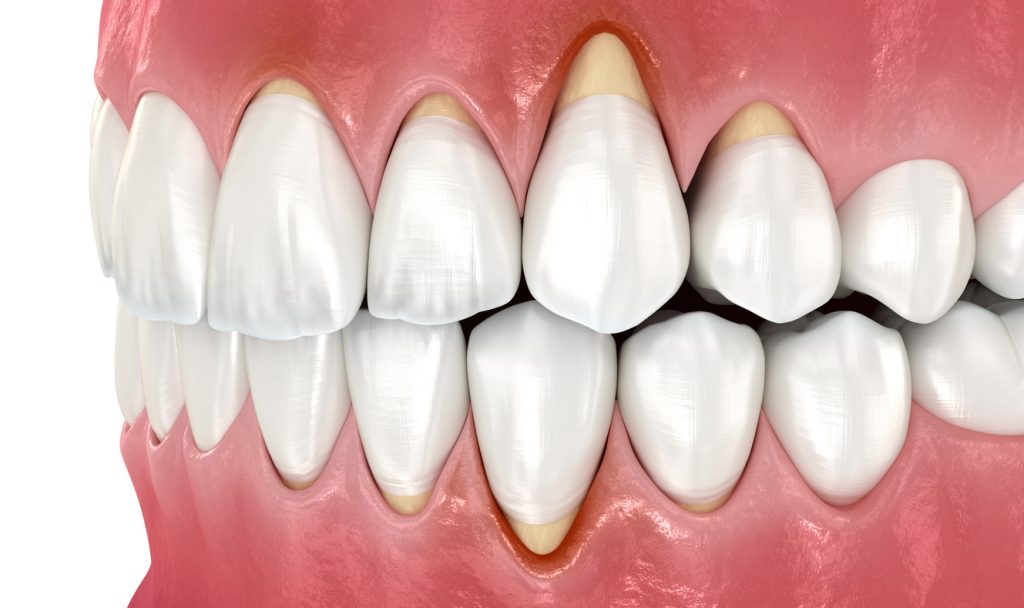
Helping Your Gums Keep Your Dental Health from Unraveling
Healthy, pink gums are a part of your smile but more importantly, healthy gums are a living protective shield for your mouth including teeth and jaw bone. Though they may appear to be simply covering the lower part of your teeth, your gums have a carefully knit connection with each tooth’s surface.
Tooth health is in danger when gums pull away from the teeth leaving a periodontal pocket. Periodontal restoration from gum recession is important to keep your mouth and body healthy.
Fortunately for those with some degree of gum recession, there are effective treatment options. Treatment depends on the cause of the issue. If the issue has nothing to do with hygiene habits, then there are quick and simple treatments like pinhole gum surgery. However, if the issue has to do with the progression of gum disease, then treatment may include a Laser-Assisted New Attachment Procedure (LANAP). LANAP can revitalize the gum-tooth connection and restore health and protection.
What Is the Gum-Tooth Connection, and Why Is It So Vital?
Gums don’t just cover the roots of your teeth, they also form a living seal around the tooth that keeps bacteria from entering and protects both the tooth root and bone below.
Dental plaque is a sticky soft film of bacteria that is constantly forming on the surface of your teeth, especially after eating. Any plaque remaining on the teeth after brushing and flossing eventually hardens. This is called tartar, a hardened version of plaque. Tartar is difficult to remove and irritates the gums causing inflammation. The constant inflammation causes the gums to pull away from the teeth.
As the gum tissue continues to pull back, it leaves a vulnerable gap called a gingival pocket where bacteria and food particles enter and cause infection. The risk to teeth, gums, and jaw bones increases as this gum recession process continues.
Gum Recession Happens for Several Reasons
Gum recession treatment isn’t just due to neglect. Issues can develop from natural causes like teeth that grow out of alignment. Over-brushing or brushing too hard can also wear down gum tissue and cause thinning even with the best intentions to keep your mouth healthy. Other conditions such as dry mouth, smoking, or a mouth that is otherwise too hospitable for bacteria can damage the tooth-gum support connection.

Many problems that lead to gum recession develop over time. A dental professional can identify these issues and provide recommendations and treatments to prevent further issues. For example, a dentist can tell you if you are brushing too hard or not brushing enough. A dentist can teach you the proper way to floss and take care of your gums. Daily brushing removes plaque before it hardens into tartar. However, it’s difficult to reach all areas of the teeth and some tartar can develop. Regular dental checkups are important because tartar removal requires a dental professional.
Let’s review some of the procedures that can restore your dental health.
Loss of Healthy Gums Can Be Restored Through Cleanings, Root Planing, and Other Procedures
Without targeted gum recession treatment, deepening pockets form around a tooth and its root. Procedures like scaling and root planing can begin the journey back to gum health. These are similar to routine cleanings, but go deeper on the tooth surface. Local anesthetic can be used, since these procedures work on the more sensitive parts of the lower tooth.
Gingival pockets, due to gum recession, develop bacterial infections easily. The need for thorough treatments that extend deep into the gums, along with antibiotics, becomes more pressing.
Eventually, problems can include decay of the tooth root surface and connected bone. New laser-assisted regeneration (LAR) techniques including Laser-Assisted New Attachment Procedure (LANAP) offer targeted, highly effective treatment deep around the tooth’s root.
With a thorough cleanup of damage and infection, you have a better chance of faster, more straightforward gum health recovery and prevention of more complex issues.
Gum Surgery and Replacement
How can you protect your teeth when the gums are no longer doing their job properly? Fortunately, in addition to prevention and reversal of gum problems, actual replacement of lost gum coverage is available. Depending on your situation, several types of surgical techniques may be available, with cosmetic as well as protective benefits.
Gum grafting restores coverage of the tooth root with soft natural material such as that found in the palate on the roof of your mouth. Grafting is performed when gum recession occurs due to naturally thin gums, as well as for developing oral health issues. Effectively restoring coverage of your tooth roots and the bone below, this gum surgery technique can take a week or two of recovery.
Pinhole gum surgery uses existing gums in place and expands them to restore protection. A series of specially designed pinhole cuts allow the gums to be pulled further back over the exposed tooth root. Less involved than gum grafting surgery, the pinhole technique allows recovery and cosmetic improvement in as little as one or two days.
Education Is Part of Periodontal Care
If you need gum recession treatment due to over-brushing or other oral care issues, information about related oral care techniques like brushing and flossing can help avoid gum problems or speed recovery.
If you’re a smoker, learning how to minimize the impact of smoking on your gums can help. For those with inherited tooth and gum issues that typically lead to gum recession, here’s your opportunity.
Dr.Scharf, a Long Island Periodontist can help you avoid the need for gum recession treatment with preventive dental and periodontal care.
